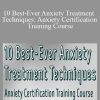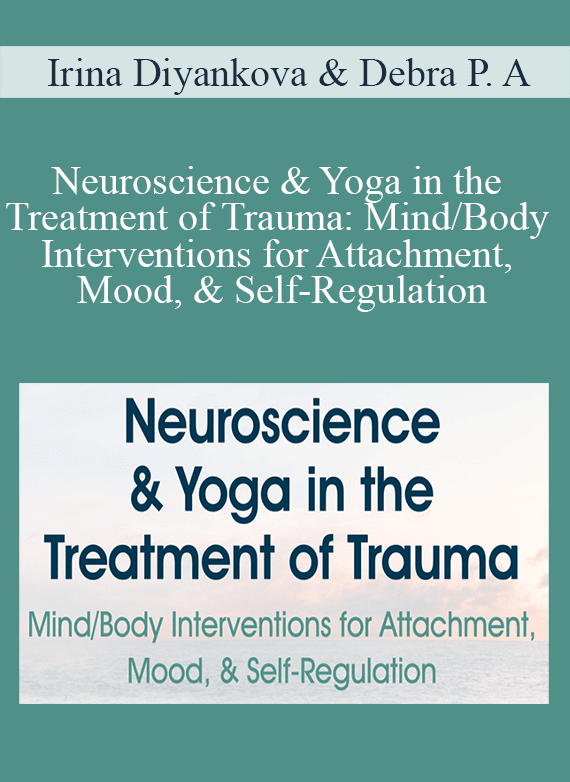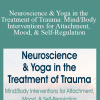Irina Diyankova & Debra Premashakti Alvis – Neuroscience & Yoga in the Treatment of Trauma: Mind/Body Interventions for Attachment, Mood, & Self-Regulation
$149.00 Original price was: $149.00.$44.00Current price is: $44.00.
Digital Download: You will receive a download link via your order email
Should you have any questions, please contact us: [email protected]
 Irina Diyankova & Debra Premashakti Alvis – Neuroscience & Yoga in the Treatment of Trauma: Mind/Body Interventions for Attachment, Mood, & Self-Regulation
Irina Diyankova & Debra Premashakti Alvis – Neuroscience & Yoga in the Treatment of Trauma: Mind/Body Interventions for Attachment, Mood, & Self-Regulation
Adding this one thing to your talk therapy practice can fast-track the healing process for trauma survivors
Do you sometimes feel like your trauma clients are stubborn and unwilling to change?
They make little to no progress in their treatment…
Even though you see them consistently and use the talk therapy tools that you know work.
This is a common frustration with therapists. And clients.
You see, your clients WANT to get better…
But they can’t do it with talk therapy alone.
Trauma is more than psychological. It’s physical
The last two decades of neuroscience research proves trauma is stored in the body.
Trauma rewires the nervous system…
Keeping survivors’ bodies stuck in an exhausting state of fight, where they feel “keyed up,” anxious and overreact to sudden loud noises or crowds.
Or, they’re stuck in flight mode, characterized by emotional numbing, depression and disassociation from their bodies.
These torturous somatic responses can dominate the body for years after the traumatic event has ended…
Making your clients feel like strangers in their own bodies.
They have the desire and motivation to heal…
But without addressing trauma at the physical level, they’ll always be stuck in that post-traumatic state.
For clients to be at peace, you must help them release the physical trauma and once again befriend their body.
Discover the ancient practice savvy therapists use to help their clients break free from the crippling grip of trauma…
…Faster and easier than with talk therapy alone
Talking alone cannot discharge stored emotional memory.
Mindful movement, such as yoga, is required to release that stored energy and re-establish the mind-body connection…
And you don’t have to be a certified yoga professional—or have super flexibility—to get these benefits in your practice.
All you need to get started is this new online course!
What Is Yoga and Why Is It Useful in Your Practice?
People across the world have been practicing yoga for more than 5 millennia. This is no fad movement.
Yoga practitioners use breathwork, mindfulness and physical poses to connect the breath, body and mind to turn the attention inward.
This allows a person to recognize habitual thought patterns and cultivate moment-to-moment awareness – which are essential elements of healing.
Why Yoga Is Effective in Trauma Treatment
Yoga helps trauma survivors to:
- Soothe their anxious minds so they engage in the present moment and tune into their bodies
- Empower themselves to make choices, which trauma often strips from survivors
- Create a positive, compassionate relationship with their body, mind and self
- Discover and use tools for self-regulation and processing sensations and emotions
- Release stored trauma memories so their brain and nervous system can regulate
- Live safely in their bodies in the present
- And much more
A recent study of women with chronic, treatment-resistant PTSD revealed that yoga:
- Significantly reduced the severity of PTSD symptoms,
- Reduced the incidence of self-harm activities,
- Decreased dissociative and depressive symptoms, and
- Increased the likelihood of loss of PTSD diagnosis
And this all happened after just 10 yoga sessions.
Long-term follow-up of the study revealed that an ongoing yoga practice helped to maintain these benefits.
Now you can incorporate elements of this ancient practice into your clinical work to help your clients finally break free from the immobilizing grip of trauma.
PART 1: Neuroscience & Yoga in the Treatment of Trauma
- How your clients experience yoga in the body
- How to quickly apply this practice to your work with trauma survivors
- Psychological/emotional trauma
- Single vs. repeated vs. extended trauma
- Developmental trauma
- Complex trauma
- How and why the brain and nervous system get “stuck” when trying to process a traumatic event
- Why a survivor’s post-trauma autonomic nervous system (ANS) creates narrow “windows of tolerance”—and how yoga can help widen them
- Simple sitting and standing yoga poses and their clinical applications
- Brain structures implicated in trauma and PTSD
- How trauma changes the brain and nervous system—and how they can heal
- Mountain Pose to come into the present and release negative emotions
- Forward Fold soothes an anxious nervous system and encourages introspection
- Breath of Joy boosts mood and reduces fatigue and depression
- Moving Warrior Poses help to heal shame and increase a sense of control in the body
- Dancing Tree Pose encourages balance in the body, which can be difficult for trauma survivors because of changes in their nervous system
- And more!
- The triune brain and how yoga calms the amygdala and sympathetic nervous system
- How yoga encourages both top-down and bottom-up regulation
- What yoga is—and is not—and how it can be applied clinically
- Debunking myths and misconceptions about yoga and who it’s for
- Research findings on yoga in the treatment of trauma
- Specific things to pay attention to when using yoga in treating a trauma survivor
- Integrating trauma-sensitive yoga in clinical work
PART 2: Bringing Trauma-Informed Yoga into Mental Health Clinical Practices
- What are “bells of mindfulness”
- How to keep you—and your clients—in the present moment
- Where the research on yoga and trauma stands right now
- Why yoga as a mind-body-spirit approach is so helpful in treating trauma
- How to work with yoga teachers to help clients develop an effective practice in conjunction with clinical treatment
- The (short) history and purpose of yoga
- How trauma—and yoga—affects people at the cellular level
- Yoga’s effect on heart rate variability (HRV)
- How yoga improves vagal nerve tone to improve resiliency
- How somatic therapy through yoga can stabilize the ANS to reduce anxiety, depression and chronic stress
- What is “shock structure” and how it relates to trauma
- How yoga can increase positive experiences in trauma survivors
- Discover strategies that discharge the nervous system and restore a resting baseline in trauma survivors
- How trauma-sensitive yoga differs from other kinds of yoga
- Breathwork to help calm rising panic
- What the research reveals about how yoga and breathwork helps trauma survivors
- Use yogic breathwork to calm and regulate the ANS
- Examples of yogic breathing exercises you can use with your clients
- How to use and apply the principles and practices of trauma-informed yoga
- Chair yoga sequences that help your clients discharge trauma in their body
- How the deep relaxation of yoga nidra can help regulate the ANS
- Evaluating your clients to ensure this type of treatment is appropriate
- Suggestions for opening and closing sessions with trauma survivors
You’ll also receive clear, written instructions for all postures and breathwork used throughout the course.
Meet the Course Experts:

Irina Diyankova, Ph.D., RYT-200, is a licensed psychologist in private practice in Knoxville, TN and a registered yoga teacher. She specializes in the treatment of complex and developmental trauma, including PTSD, dissociative disorders, and anxiety and mood disorders.
Dr. Diyankova completed her yoga teacher training in Subtle Yoga® with Kaoverii Weber in Asheville, NC. Currently, she is studying for the 500-hour yoga teacher certification with the Himalayan Institute in Honesdale, PA. She also completed part of her yoga studies with the Himalayan Institute in Allahabad, India.
Dr. Diyankova received her undergraduate degree in psychology from Moscow State University, and both her M.S. in psychology and Ph.D. in counseling psychology from Iowa State University. She has made numerous presentations on trauma and yoga to clinical audiences in the United States, United Kingdom, Mexico and Russia. She also maintains a blog, www.healingt.blogspot.com, that highlights the holistic approach she takes to trauma treatment. Learn more about Dr. Diyankova at www.dr-irina.com
Speaker Disclosures:
Financial: Irina Diyankova maintains a private practice. She has an ownership interest in Healing Trauma: Yoga for Healing Trauma online classes. Dr. Diyankova receives a speaking honorarium from PESI, Inc.
Non-financial: Irina Diyankova is a member of the American Psychological Association.

Debra Premashakti Alvis, PhD, is a licensed psychologist and private practitioner who developed and led the Mind/Body Program at the University of Georgia that specializes in addressing anxiety, stress and depression in individuals with physical health concerns and co-morbid mental health issues.
In more than 25 years of clinical experience in treating clients with anxiety, Dr. Alvis has found that she can help clients recover from anxiety more quickly, and more effectively sustain the gains made in therapy, by combining brain-based principles, body-oriented techniques and traditional psychotherapeutic approaches.
Dr. Alvis lectures and leads retreats around the world. Her trainings have helped thousands of clinicians to integrate the richness of contemplative practices and somatic psychotherapies with cognitive approaches for greater clinical effectiveness. Dr. Alvis maintains a private practice in Georgia where she treats clients with anxiety, trauma, shame, depression and relational concerns.
She also continues to work as a professor at the University of Georgia where she supervises the clinical work of doctoral students and co-leads a research team investigating mindfulness.
Speaker Disclosures:
Financial: Debra Premashakti Alvis is in private practice. She receives compensation as a Professor for the University of Georgia. Dr. Alvis receives a speaking honorarium from PESI, Inc.
Non-financial: Debra Premashakti Alvis has no relevant non-financial relationship to disclose.
Sale Page: https://catalog.pesi.com/sales/bh_c_001342_neuro_yoga_trauma_organic-95784
Archive: https://archive.fo/2ebuz





Reviews
There are no reviews yet.